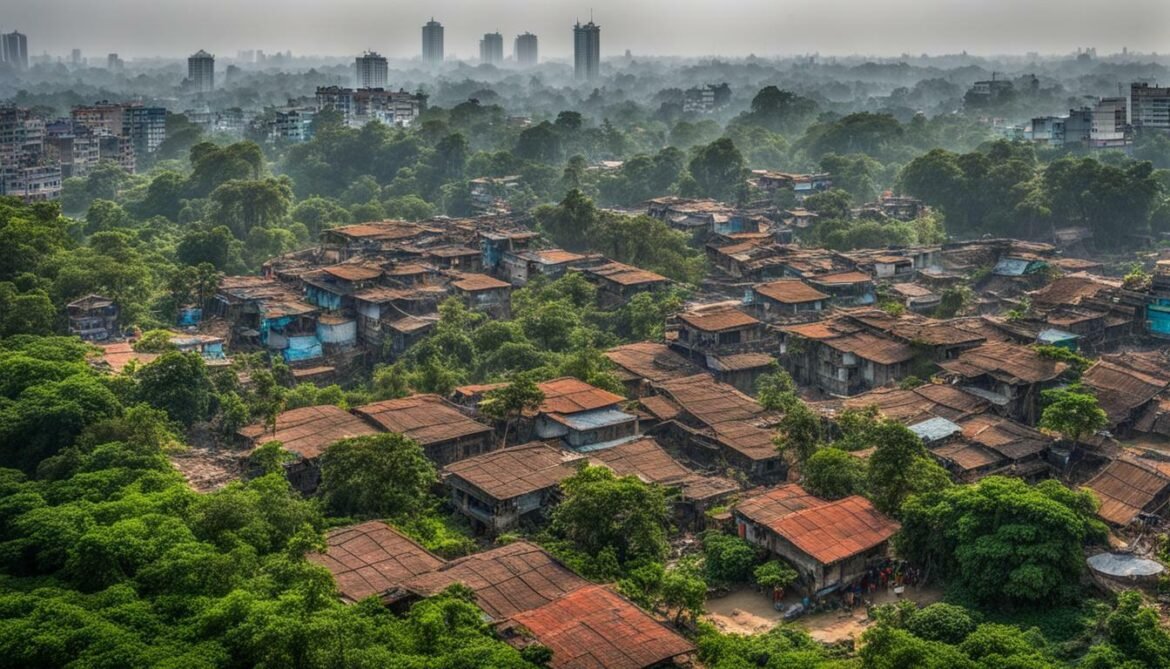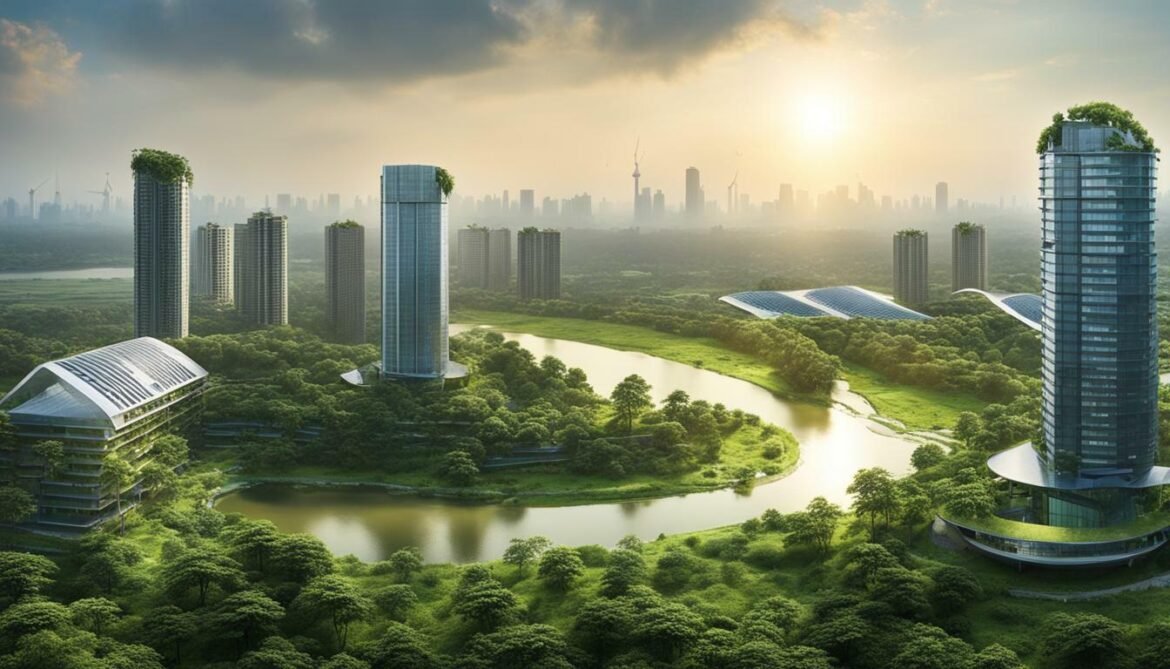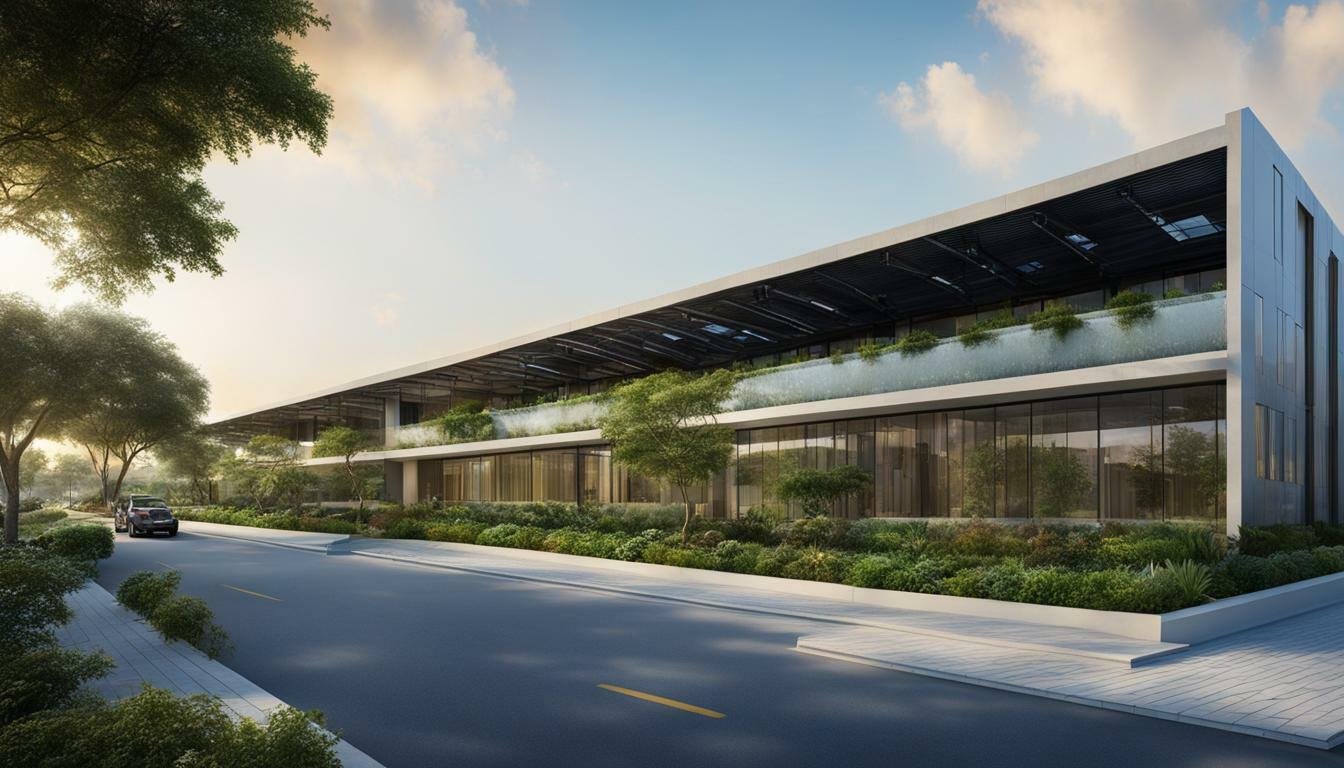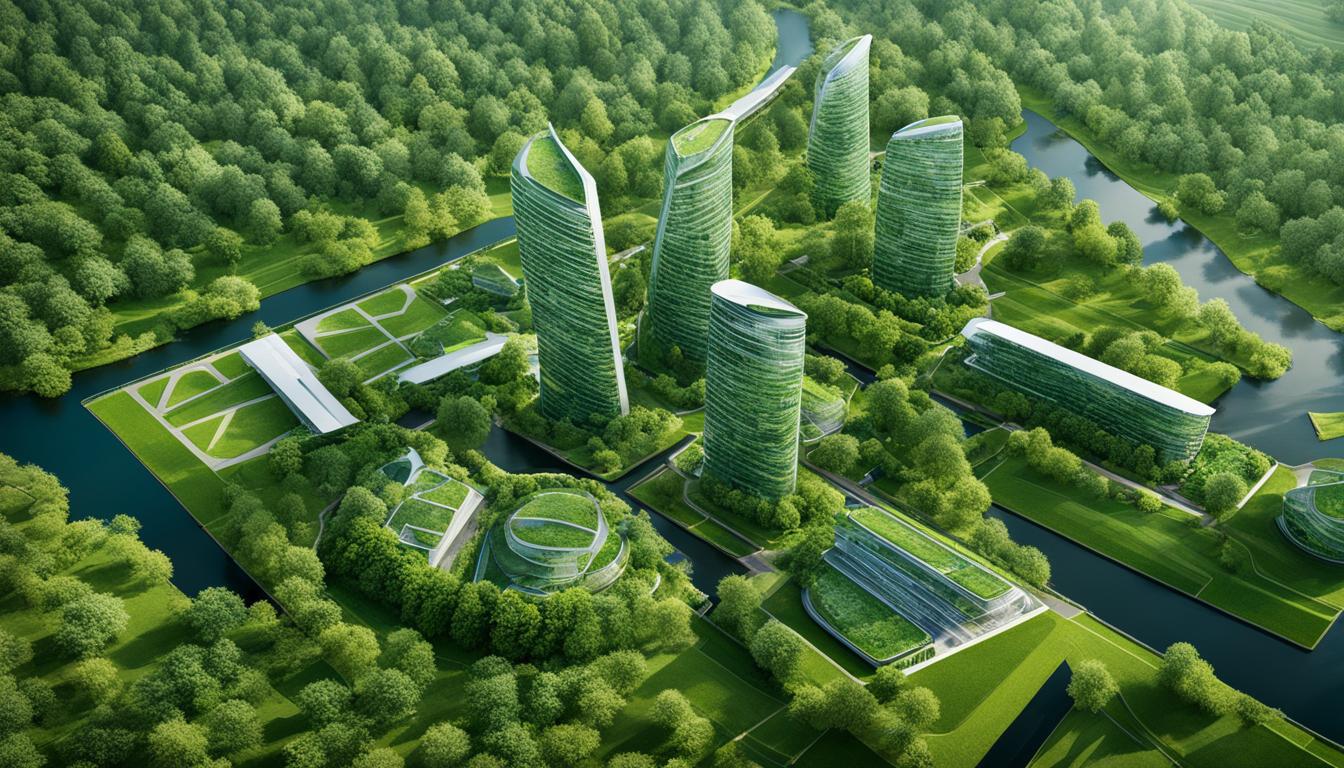Explore Bangladesh Green Building: Sustainable Future Blueprint
Bangladesh is a developing country in South Asia that faces various challenges when it comes to sustainable development. With its rapidly growing population and increasing urbanization, there is a pressing need to implement green building practices that can contribute to a sustainable future. This article aims to explore the concept of green building in Bangladesh and highlight its importance in creating a blueprint for a sustainable future.
Key Takeaways:
- Green building in Bangladesh promotes sustainable materials, energy conservation, water management, and healthy living environments.
- Green building can help mitigate climate change, create energy-efficient buildings, conserve water, minimize waste generation, and promote a healthy living environment in Bangladesh.
- The Green Building Certification Institute (GBCI), government initiatives, and awareness and education programs are driving the adoption of green building practices in Bangladesh.
- Challenges to green building in Bangladesh include lack of awareness, high initial cost, and limited technical expertise, while opportunities include increasing demand for energy-efficient buildings, renewable energy sources, and potential job creation.
Green Building Principles in Bangladesh
Green building refers to the practice of constructing structures that are environmentally friendly, resource-efficient, and socially responsible. In Bangladesh, the adoption of green building practices has gained popularity in recent years, focusing on using sustainable materials, reducing energy consumption, conserving water, and promoting healthy living environments.
| Principle | Description |
|---|---|
| Sustainable Materials | Green buildings in Bangladesh use sustainable materials such as bamboo, recycled wood, and fly ash bricks to reduce environmental impact and promote responsible resource use. |
| Energy Consumption | Green buildings incorporate energy-efficient features such as insulation, efficient lighting systems, and renewable energy sources like solar panels. These measures significantly reduce energy consumption and contribute to a more sustainable energy future. |
| Water Conservation | Green buildings in Bangladesh prioritize water-conserving measures such as rainwater harvesting, water-efficient fixtures, and greywater recycling. This helps to address the challenges of water scarcity and promotes responsible water management. |
| Healthy Living Environment | Green buildings prioritize the use of non-toxic materials and effective ventilation systems to ensure a healthy indoor environment. This is particularly important in Bangladesh, where rapid urbanization has led to increased pollution levels and health risks. |
The use of these principles in construction can help to create sustainable buildings that are not only environmentally friendly but also socially and economically responsible.

Importance of Green Building in Bangladesh
The adoption of green building practices in Bangladesh is crucial for mitigating the effects of climate change and promoting sustainable development. The country is already experiencing the impacts of climate change, including increased frequency of floods and cyclones, sea-level rise, and water scarcity. By implementing green building practices, Bangladesh can reduce its environmental impact and contribute to a sustainable future.
Climate Change Mitigation
Bangladesh is one of the countries most vulnerable to the effects of climate change, with rising sea levels and flooding posing a significant threat to the country’s population and economy. By adopting green building practices, the country can reduce greenhouse gas emissions and mitigate the effects of climate change.
Energy Efficiency
Green buildings in Bangladesh incorporate energy-efficient features such as insulation, efficient lighting systems, and renewable energy sources like solar panels. These measures significantly reduce energy consumption and contribute to a more sustainable energy future.
Water Conservation
With water scarcity becoming a growing concern, green buildings in Bangladesh prioritize water-conserving measures such as rainwater harvesting, water-efficient fixtures, and greywater recycling. This helps to address the challenges of water scarcity and promotes responsible water management.
Waste Reduction
Green buildings focus on reducing waste generation by incorporating recycling and waste management systems. This not only helps to minimize environmental impact but also promotes a culture of responsible waste disposal within the population.
Healthy Living Environment
Green buildings prioritize the use of non-toxic materials and effective ventilation systems to ensure a healthy indoor environment. This is particularly important in Bangladesh, where rapid urbanization has led to increased pollution levels and health risks.
Green Building Initiatives in Bangladesh
In recent years, Bangladesh has taken steps towards promoting green building practices. Here are some of the initiatives:
Green Building Certification
The Green Building Certification Institute (GBCI) has introduced the Leadership in Energy and Environmental Design (LEED) certification in Bangladesh, which evaluates the sustainability performance of buildings and encourages the adoption of green building practices.
Government Initiatives
The Bangladesh government has introduced guidelines and regulations for the construction of environmentally friendly buildings, and offers tax incentives and subsidies to developers who adopt green building practices.
Awareness and Education
Several organizations and institutions in Bangladesh are actively engaged in raising awareness about green building practices. They conduct workshops, training programs, and seminars to educate architects, engineers, and other stakeholders about sustainable construction techniques.
Challenges and Opportunities
The adoption of green building practices in Bangladesh is still in its early stages, and several challenges need to be addressed:
- Lack of awareness
- High initial cost of green building materials
- Limited technical expertise in sustainable construction
Despite these challenges, there are significant opportunities for growth:
- Increasing demand for energy-efficient buildings
- Availability of renewable energy sources
- Potential for job creation in the green construction sector
Overall, the green building movement in Bangladesh holds great promise for creating a sustainable future. With continued government support and increased awareness among stakeholders, Bangladesh can pave the way for a more sustainable and resilient built environment.

Green Building Initiatives in Bangladesh
Bangladesh has taken significant steps to promote green building practices through certifications, government initiatives, and awareness programs. These initiatives have contributed to the growing adoption of sustainable construction practices in the country.
One of the key initiatives is the introduction of green building certification by the Green Building Certification Institute (GBCI). The Leadership in Energy and Environmental Design (LEED) certification has been introduced in Bangladesh to evaluate the sustainability performance of buildings and encourage the adoption of green building practices. This certification has helped to raise awareness and incentivize developers to adopt sustainable building practices.
The Bangladesh government has also played a significant role in promoting green building practices. The Department of Environment has introduced guidelines and regulations for the construction of environmentally friendly buildings. Additionally, tax incentives and subsidies are offered to developers who adopt green building practices. The government’s efforts have helped to create a more conducive environment for the growth of sustainable construction practices in the country.
Awareness and education programs have also been instrumental in promoting green building practices in Bangladesh. Several organizations and institutions are actively engaged in raising awareness about sustainable construction techniques. They conduct workshops, training programs, and seminars to educate architects, engineers, and other stakeholders about sustainable building practices. These programs have helped to create a pool of skilled professionals who are well-equipped to design and construct green buildings in the country.
Green Building Certification in Bangladesh
| Level of Certification | Requirements |
|---|---|
| LEED Certified | Minimum 40 points |
| LEED Silver | 50-59 points |
| LEED Gold | 60-79 points |
| LEED Platinum | 80+ points |
Green building certification has become increasingly popular in Bangladesh. The table above shows the different levels of certification available under the LEED system and the minimum requirements for each level. Certification helps to ensure that buildings are constructed according to sustainable principles and encourages developers to adopt green building practices. It also helps to increase the value of the property and contributes to a more sustainable built environment.

The certification process evaluates the sustainability performance of buildings based on various criteria, including energy efficiency, water conservation, indoor environmental quality, and sustainable site development. Buildings that meet the minimum requirements for certification are awarded a certificate that demonstrates their commitment to sustainability.
Challenges and Opportunities for Green Building in Bangladesh
While the adoption of green building practices in Bangladesh is growing, several challenges need to be addressed to unlock the opportunities for sustainable development. One of the major barriers to the widespread adoption of green building practices is the lack of awareness among stakeholders, including developers, architects, and engineers. Many still believe that green buildings are expensive and difficult to construct.
Another hurdle to the adoption of green building practices is the high initial cost of sustainable materials. However, it is important to note that the long-term benefits of green buildings outweigh the initial costs. Green buildings are energy-efficient, reducing the costs of energy bills and providing a return on investment in the long run.
Technical expertise in sustainable construction is also limited in Bangladesh. Training and education programs are needed to equip builders and engineers with the necessary skills to construct green buildings. However, the availability of renewable energy sources in Bangladesh presents a significant opportunity for growth in sustainable construction, particularly in the use of solar power and wind energy.
Another opportunity for growth is job creation in the green construction sector. The adoption of green building practices will require a skilled workforce, presenting an opportunity for job creation at various levels from the construction site to the manufacturing of green building materials.
In conclusion, while challenges exist, the adoption of green building practices in Bangladesh presents an opportunity for sustainable development and a means of addressing the challenges of climate change, energy efficiency, water conservation, waste reduction, and promoting a healthy living environment. Through continued government support and increased awareness and education among stakeholders, Bangladesh can become a leader in sustainable construction and pave the way for a more sustainable future.

Conclusion
The green building movement in Bangladesh holds great promise for creating a sustainable future. With its growing population and urbanization, it is vital that the country adopts environmentally friendly practices in construction. Green building principles, such as using sustainable materials, reducing energy consumption, conserving water, and promoting healthy living environments, can help to address the challenges of climate change and promote a more sustainable future.
The importance of green building in Bangladesh cannot be overstated. By mitigating climate change, reducing energy consumption, conserving water, and promoting waste reduction, green building practices offer tangible benefits for the environment and the population. Initiatives such as LEED certification, government regulations, and awareness programs are helping to drive the adoption of green building practices in the country.
Despite significant opportunities for growth, such as renewable energy sources and job creation, challenges such as lack of awareness, high costs, and limited technical expertise must be addressed. With continued government support and increased awareness among stakeholders, Bangladesh can pave the way for a more sustainable and resilient built environment.
FAQ
Q: What is green building?
A: Green building refers to the practice of constructing structures that are environmentally friendly, resource-efficient, and socially responsible.
Q: Why is green building important in Bangladesh?
A: Green building is important in Bangladesh to mitigate climate change, improve energy efficiency, conserve water, reduce waste, and promote a healthy living environment.
Q: What are the green building initiatives in Bangladesh?
A: Green building initiatives in Bangladesh include the introduction of green building certification, government regulations and incentives, and awareness and education programs.
Q: What are the challenges and opportunities for green building in Bangladesh?
A: Challenges for green building in Bangladesh include lack of awareness, high initial cost, and limited technical expertise. However, there are opportunities for energy-efficient buildings, renewable energy sources, and job creation in the green construction sector.








Bangladesh Biodiversity: Animal and Plant Species and What Is Under Threat
1 year ago[…] You may also be interested to read about Green Building in Bangladesh. […]